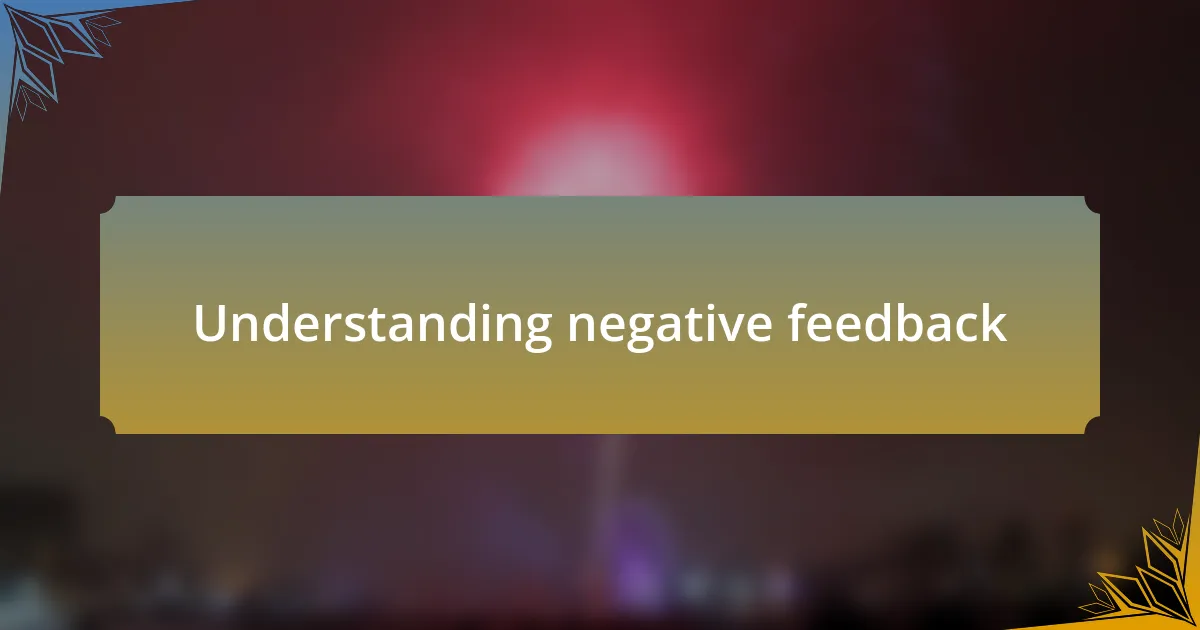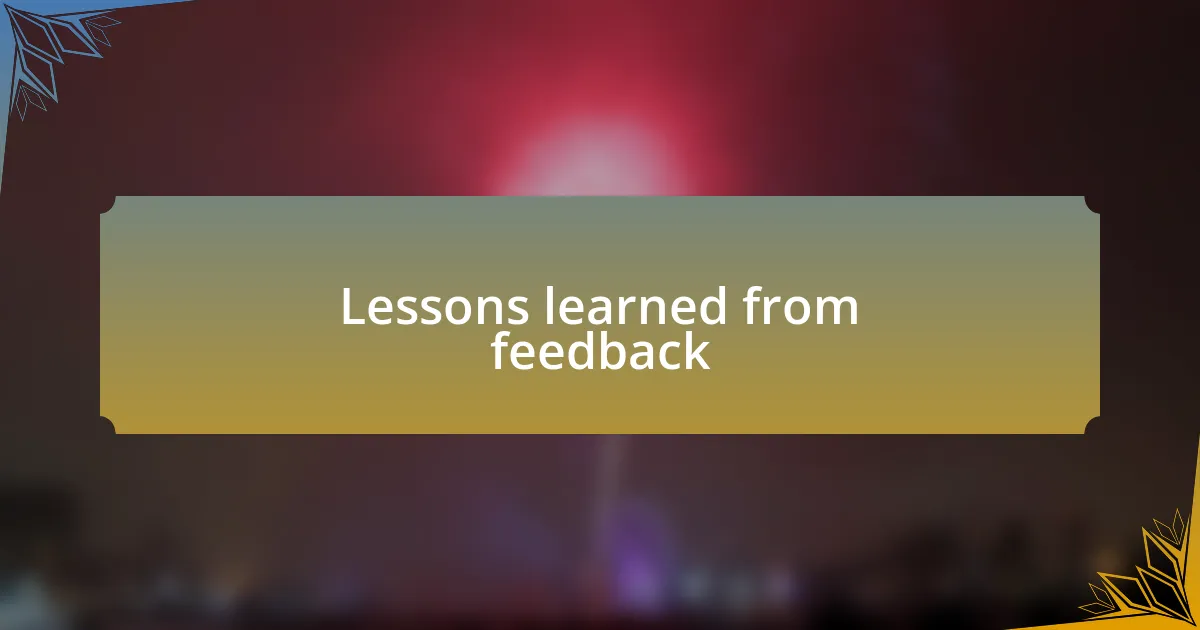Key takeaways:
- Negative feedback provides valuable insights into unmet customer expectations, prompting opportunities for improvement.
- Acknowledging customers’ emotions and responding with empathy can transform negative interactions into constructive dialogues.
- Transparency and follow-up after addressing issues foster trust and build long-lasting customer relationships.
- Feedback serves as a critical tool for personal and organizational growth, highlighting blind spots and areas for enhancement.

Understanding negative feedback
Negative feedback can often feel like a punch to the gut, can’t it? I recall a time when a customer described our service as “frustrating” and “disappointing.” Initially, I bristled at the words, but upon reflection, I realized this was a genuine opportunity to derive meaning from someone else’s experience. It’s essential to understand that negative feedback often stems from unmet expectations, and if we view it through that lens, we can begin to uncover the underlying issues.
When I dive into negative feedback, I find myself asking why the experience didn’t meet the customer’s standards. For instance, a client once pointed out that our response times were slower than anticipated. This led me to analyze our processes and eventually implement changes that not only improved response times but also enhanced overall customer satisfaction. It was a constant reminder that digging deeper into the feedback can unearth valuable insights that can drive real improvements.
Understanding negative feedback is not just about addressing a complaint; it’s about listening for the emotions behind the words. I remember another instance where a customer felt “ignored” during their interaction with our team. They longed for recognition, which could have changed their entire experience. This realization taught me that acknowledging feelings is as important as resolving issues – it paves the way for a more positive relationship moving forward. Why wouldn’t we want to create connections based on understanding and empathy?

Common sources of negative feedback
Often, I find that negative feedback emerges from specific touchpoints during a customer’s journey. For example, a client once expressed dissatisfaction with the clarity of our website’s navigation. This experience resonated with me because I too have felt lost on a confusing site, and it made me realize just how vital it is to streamline user experience. What if that simple fix could enhance engagement and retain customers?
Another significant source of negative feedback can be associated with communication gaps. There was a time when a customer left a review lamenting how our onboarding process lacked guidance. At that moment, I felt a mix of disappointment and empathy. It reminded me of my own struggles when navigating new systems without adequate support. It makes me ponder: what tools can we implement to ensure our customers feel supported from the get-go?
Additionally, customer expectations play a pivotal role in shaping their feedback. There was a situation where a user anticipated a product feature based on marketing materials but found it missing upon use. Their frustration was palpable, and it served as a powerful reminder of the importance of aligning marketing messages with actual offerings. How often do we overlook the implications of our promises? This experience reinforced the need for honesty and transparency in customer interactions to prevent disappointment down the line.

Strategies for addressing negative feedback
When addressing negative feedback, one effective strategy I’ve employed is to actively listen and acknowledge the customer’s feelings. I recall a situation where a client expressed frustration about delayed service. Rather than becoming defensive, I took a moment to empathize and validate their experience. It was a turning point for me. I learned that simply stating, “I understand how that must have felt,” can turn a negative encounter into a constructive dialogue.
Another important tactic is to respond quickly and transparently. There was an instance where a customer posted a public complaint about a technical glitch. I responded almost immediately, outlining the steps we were taking to resolve the issue. This not only reassured the customer but also showed others that we value their feedback and are committed to improvement. Isn’t it fascinating how transparency can transform a crisis into an opportunity for building trust?
Additionally, I find that following up after resolving an issue creates a relationship that stretches beyond the initial problem. A few months after addressing a negative comment about our product, I reached out to see how the customer was faring. Their response was overwhelmingly positive; it was gratifying to witness their change in perception and to know we had made an impact. Doesn’t it make sense that ongoing engagement can foster loyalty? This approach has taught me the importance of building long-lasting connections, rather than just focusing on immediate solutions.

Personal experiences with negative feedback
Negative feedback can be quite unsettling, but I’ve experienced moments where it transformed my perspective. I remember a customer who criticized our service in what felt like a personal attack. Instead of getting defensive, I realized I had a choice: I could either dwell on the sting or take it as a cue for growth. It was a humbling moment that taught me resilience and the real essence of customer service.
There was one particular instance where a review highlighted flaws in our product, pointing out aspects I hadn’t even noticed. Initially, it was disheartening to see our shortfalls laid bare, but I decided to dive deeper into the feedback. Upon reflection, I actually appreciated the customer’s honesty. Their critique pushed me to initiate improvements that ultimately enhanced our offering, reminding me that discomfort often paves the way for innovation. Isn’t it intriguing how a single piece of negative feedback can ignite positive changes?
In another experience, I received an email from an upset client who pointed out inconsistencies in our communication. At first, I felt defensively inclined to justify our process, but instead, I took a step back. After reaching out to clarify their concerns and expressing gratitude for their input, I felt a wave of relief wash over me. That conversation ended up building a stronger rapport. It made me wonder: could it be that the most difficult interactions often lead to the most valuable lessons in customer relationships?

Lessons learned from feedback
When I look back on my journey with negative feedback, one experience stands out. A customer once pointed out a critical error in a marketing campaign I had proudly championed. Initially, I felt a wave of embarrassment wash over me; however, as I reflected on their input, I recognized it was a chance to reassess my approach. Accepting that feedback not only helped refine my skills but also reminded me that vulnerability can lead to profound growth.
Another lesson I learned was how to differentiate between constructive criticism and mere complaints. I recall facing a situation where a user was frustrated with a bug in our software. Instead of brushing it off, I engaged with them, asking for more specifics. That interaction not only resolved the issue for that user but also highlighted a gap in our testing process I hadn’t considered. This experience taught me the importance of actively seeking clarity from critics; it’s often in those conversations that the most actionable insights emerge.
Then there’s the powerful notion that feedback can serve as a mirror. One time, I received comments reflecting my team’s communication style, which I had always viewed as clear. After some introspection, I came to realize that clarity is subjective. This revelation encouraged me to approach communication with empathy, constantly checking in with our audience to ensure our messages resonate. Doesn’t it make you think about how feedback can hold a lens to our blind spots, ultimately guiding us towards a more refined service?